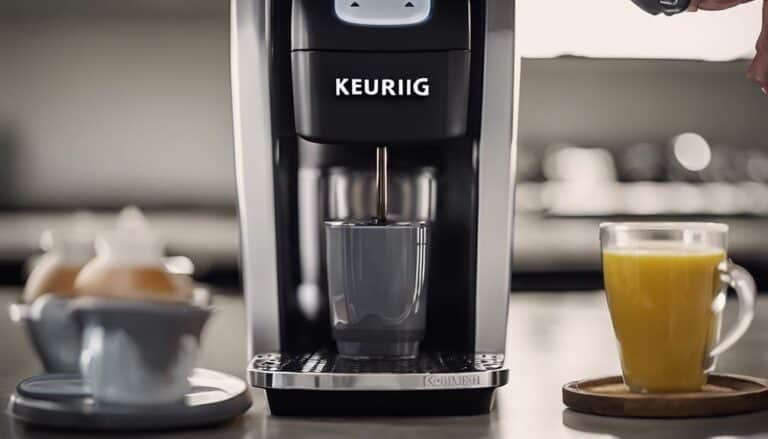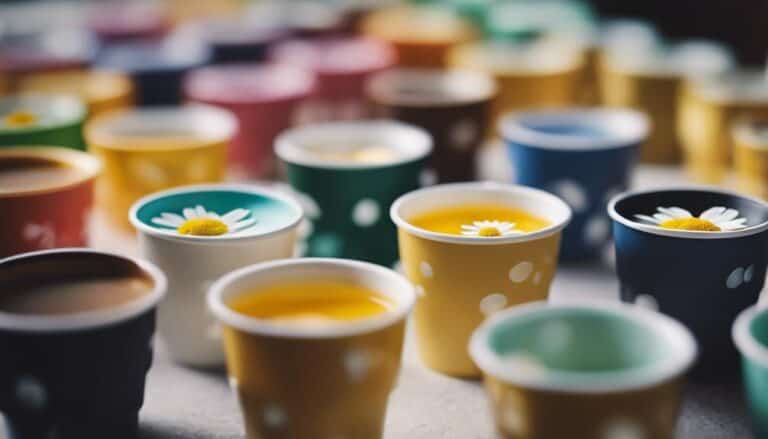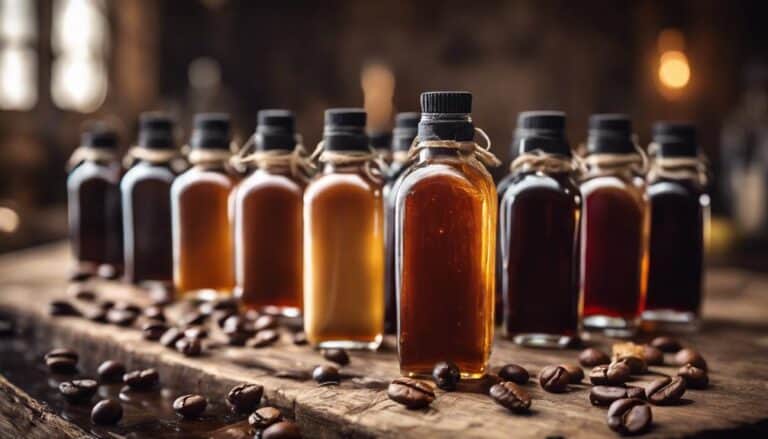Understanding Pearl Tea
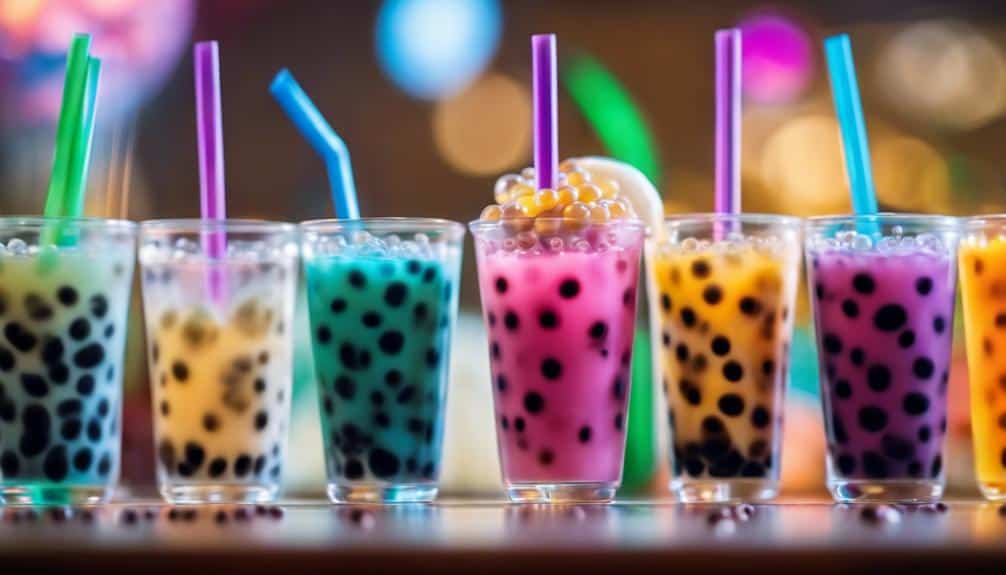
As I took my first sip of pearl tea, I couldn't help but wonder about the intricate process that goes into creating this renowned beverage. The blend of tea, milk, and chewy tapioca pearls seemed simple yet complex, hinting at a story waiting to be unraveled. From its humble beginnings to its modern-day variations, pearl tea holds secrets that beg to be uncovered. Join me as we explore the depths of this beloved drink and uncover the hidden gems that make it a favorite worldwide.
Origins of Pearl Tea
In the bustling tea culture of Taiwan in the 1980s, the delightful fusion of tea, milk, and tapioca pearls gave birth to the beloved beverage we now know as pearl tea, originating at the renowned Chun Shui Tang tearoom in Taichung. This Taiwanese black tea, also known as boba tea, has become a global sensation. The rich, robust flavor of Taiwanese black tea, combined with the creamy texture of milk and the chewy surprise of tapioca pearls, creates a truly unique sensory experience.
When pearl tea first emerged, it quickly captured the hearts of Taiwanese youth with its innovative blend of flavors and textures. The addition of tapioca pearls not only enhanced the drink's visual appeal but also provided an exciting twist to traditional tea consumption. The term 'bubble tea' originated from the frothy bubbles that form when the tea is vigorously shaken with milk, adding to its charm.
Pearl tea revolutionized the way people perceive and consume tea, paving the way for a myriad of variations and flavors that cater to diverse palates worldwide.
Evolution of Pearl Tea
As we delve into the Evolution of Pearl Tea, let's uncover the intriguing Origins of Pearls, the Techniques of Brewing that have enhanced its flavors, and the fascinating journey of its Popularity Across Cultures.
The evolution of this unique beverage from a local delight to a global phenomenon showcases the adaptability and creativity within the tea industry. The introduction of diverse flavors, toppings, and customization options hasn't only catered to varied consumer tastes but has also enriched the cultural significance of pearl tea worldwide.
Origins of Pearls
The journey of pearl tea's origins traces back to the vibrant streets of Taiwan in the 1980s, where a delightful fusion of traditional tea, tapioca pearls, and rich flavors gave birth to a beloved beverage sensation. Originally, pearl tea combined black tea, milk, and tapioca pearls to create a unique and indulgent drink experience. As the popularity of pearl tea grew, it evolved to include a myriad of flavors, toppings, and tea varieties, catering to diverse tastes and preferences. This evolution from a simple mixture to a customizable delight marked a significant shift in the tea industry, making pearl tea a global phenomenon enjoyed by millions worldwide.
| Tapioca Pearls | Black Tea | Milk |
|---|---|---|
| Chewy texture | Robust flavor | Creamy richness |
Techniques of Brewing
Exploring the evolution of pearl tea brewing techniques reveals a rich tapestry of innovation and refinement in the quest for the perfect cup of this beloved beverage. From traditional methods to modern equipment, the brewing process has undergone significant changes.
High-quality pearl teas are now crafted using advanced brewing technologies that allow for precise control over every element. Bubble tea shops are constantly experimenting with new flavors, textures, and presentations, pushing the boundaries of what pearl tea can offer.
Specialized tools like vacuum infusion and nitrogen systems have revolutionized how pearls are made, resulting in a diverse range of options for tea enthusiasts seeking a truly exceptional experience.
Popularity Across Cultures
Across various corners of the globe, the evolution of pearl tea, also known as bubble tea, has captivated taste buds and transcended cultural boundaries, becoming a beloved beverage enjoyed by a diverse array of people.
Originating in Taiwan, this drink has expanded globally, with bubble tea shops popping up worldwide. The popularity of milk teas with tapioca pearls has surged, appealing to different palates and preferences.
In various countries, the cultural fusion of bubble tea is apparent, showing its adaptability to different culinary traditions. The continuous innovation in bubble tea recipes and toppings keeps the drink fresh and exciting, ensuring its relevance in the global beverage market.
Pearl tea's journey from a humble street drink to a global sensation highlights its ability to bring people together through a shared love for this delightful beverage.
Ingredients in Pearl Tea
Delving into the rich tapestry of flavors in Pearl Tea reveals a harmonious blend of black or green tea, milk, sugar syrup, and tapioca pearls. The tapioca pearls, made from tapioca starch, brown sugar, and hot water, add a delightful chewy texture to the drink. This bubble tea, known for its inclusion of these unique tapioca pearls, can also include variations with fruit flavorings or jelly for added taste dimensions.
One of the most intriguing aspects of pearl tea is its customizability. You can choose different types of teas, from traditional black to fragrant green, various milks like almond or coconut, adjust sweetness levels, and even select different toppings to craft a personalized tea experience.
As you sip on a cup of pearl tea, each ingredient plays its part in creating a symphony of flavors that dance on your taste buds. The creamy milk balances the boldness of the tea, while the tapioca pearls surprise you with each chew. This delightful concoction offers a truly unique and enjoyable beverage experience.
Health Implications of Pearl Tea

As we explore the health implications of pearl tea, it's crucial to take into account both its nutritional benefits and potential risks.
While pearl tea can provide a revitalizing beverage option, its high sugar content and inclusion of artificial sweeteners may raise concerns for our health.
Understanding the impact of ingredients like milk products on calorie and fat intake can assist us in making informed choices about consuming pearl tea regularly.
Nutritional Benefits of Pearl Tea
Exploring the nutritional profile of pearl tea reveals its impact on health and well-being, shedding light on both its benefits and potential drawbacks. Pearl tea, often made with sweetened milk and sugar, can be high in calories and carbohydrates. While this mightn't be ideal for those watching their sugar intake or trying to maintain a balanced diet, the milk in pearl tea can provide essential nutrients like calcium and vitamin D.
However, the added sugar and milk products can also increase the calorie and fat content, which may not align with everyone's dietary needs. Understanding the nutritional benefits of pearl tea is essential for making informed decisions about incorporating it into your diet, considering both its positives and potential health implications.
Potential Risks to Consider
Considering the potential health risks associated with pearl tea, one must be mindful of its high sugar and calorie content to make informed choices about consumption. Bubble tea, with its tapioca pearls, can be a sugary indulgence leading to weight gain and possible health issues.
The pearls are often cooked in sweet syrup, contributing to the overall calorie and sugar content. Regularly indulging in pearl tea can heighten the risk of developing type-2 diabetes and dental problems like cavities and tooth decay.
It's essential to watch portion sizes and frequency of consumption to manage these health risks effectively. Being aware of the sugar content in pearl tea can help make healthier choices and enjoy this popular beverage more responsibly.
Consumer Awareness in Pearl Tea Industry
Delving into the world of pearl tea, understanding the importance of consumer awareness is vital for making informed choices in this thriving industry. When it comes to bubble tea, consumers should be proactive in inquiring about the source of tea leaves and the quality of ingredients used in its preparation. By understanding the brewing process, including the steeping time and temperature, consumers can enhance their awareness of the tea industry and make more educated decisions.
Moreover, being aware of the sugar content, milk options, and additives in pearl teas is essential for making healthier choices. Consumers have a significant impact on the quality of pearl tea by demanding transparency in both ingredients and preparation methods. It's essential for consumers to be knowledgeable about the health risks associated with high sugar content and artificial additives commonly found in pearl teas. By staying informed and asking the right questions, consumers can contribute towards promoting transparency and quality in the pearl tea industry.
Transparency in Pearl Tea Preparation
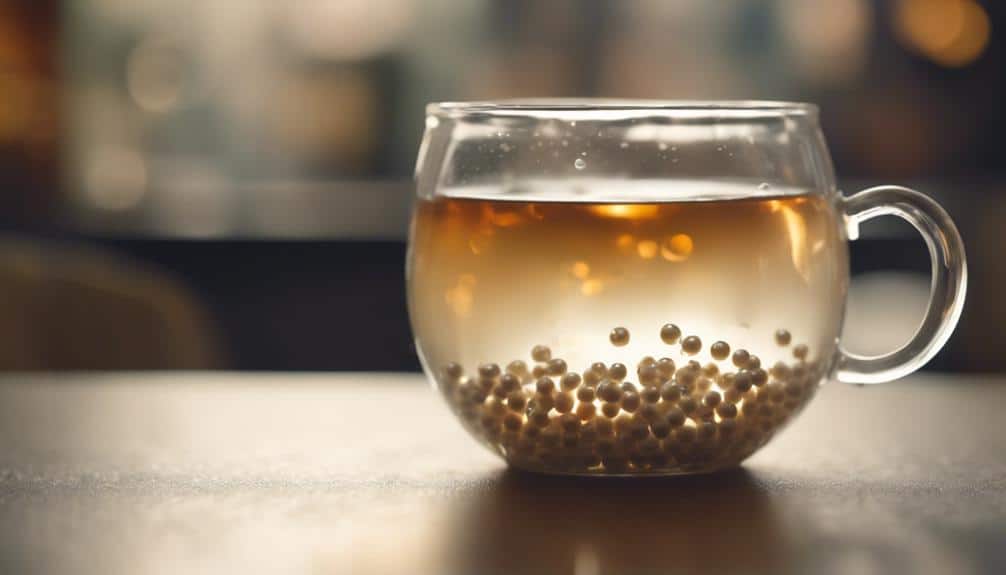
Transparency plays a pivotal role in the preparation of pearl tea, guaranteeing customers are well-informed about the ingredients and processes involved in creating this beloved beverage. When it comes to bubble tea, being forthright about what goes into each cup fosters trust and allows customers to make informed choices.
Here are five key aspects that highlight the significance of transparency in pearl tea preparation:
- Ingredient Disclosure: Openly sharing the components used, such as tapioca pearls, tea base, and milk products, gives insight into the beverage's composition.
- Sourcing Information: Providing details on where tea leaves, milk products, and flavorings come from ensures quality and authenticity.
- Process Clarity: Transparency extends to how tapioca pearls are cooked and how the tea is brewed, showcasing the dedication to quality preparation.
- Labeling Accuracy: Detailed labels that list allergens, additives, and preservatives used help customers make informed decisions based on their dietary needs.
- Customization Communication: Openly discussing customization options, sugar levels, and topping choices with customers enhances their understanding and enjoyment of pearl tea.
Conclusion
As I conclude my journey through the world of pearl tea, I'm amazed by the rich history, diverse flavors, and health implications of this beloved beverage.
From its origins in Taiwan to its global popularity, pearl tea continues to captivate taste buds worldwide.
By staying informed about the ingredients, brewing process, and health benefits, consumers can savor each sip with confidence and appreciation.
Let's raise our cups to the wonderful world of pearl tea!

